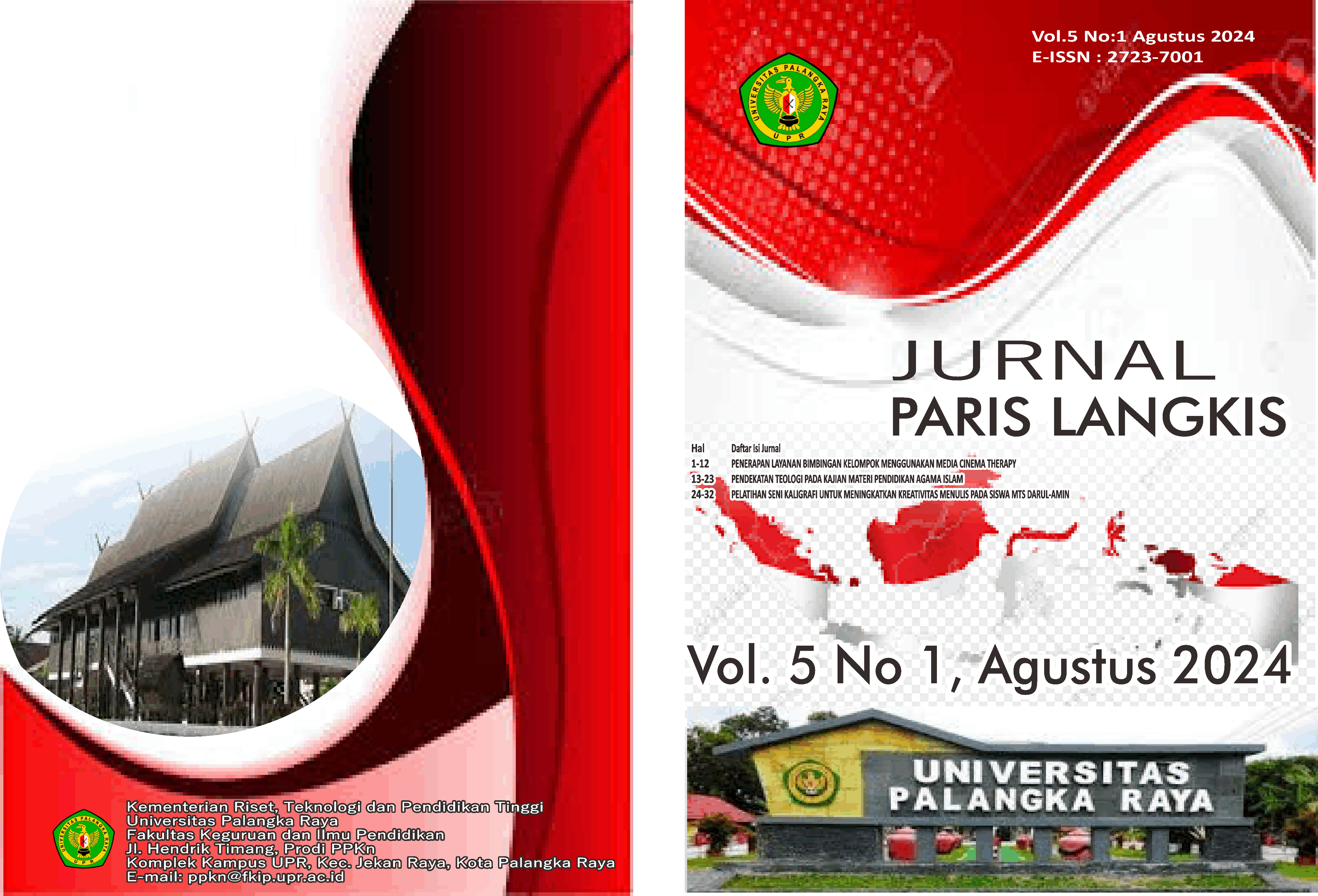EKSISTENSI PENGRAJIN GETAH NYATU MELESTARIKAN KEARIFAN LOKAL SUKU DAYAK NGAJU KALIMANTAN TENGAH
DOI:
https://doi.org/10.37304/paris.v5i1.15650Kata Kunci:
Eksistensi Pengrajin Getah Nyatu, Kearifan Lokal, Suku Dayak NgajuAbstrak
Kerajinan getah nyatu merupakan salah satu kerajinan yang menonjolkan nilai-nilai budaya yang ada di Kalimantan Tengah dalam beragam bentuk produknya. Produk kerajinan berawal dari sejarah panjang yang diwariskan turun temurun dari sang penemu awal sebagai maha karya untuk mengingatkan, mengajarkan dan melestarikan budaya asli Suku Dayak Ngaju melalui kerajinan tangan sebagai souvenir. Artikel ini merupakan kajian yang mengulas secara teoritis dan konseptual eksistensi pengrajin melestarikan kearifan lokal dalam produk kerajinan getah nyatu sebagai bagian dari produk ekonomi kreatif yang bersumber dari kehidupan masyarakat Suku Dayak Ngaju di Kalimantan Tengah. Penelitian ini menggunakan metode kualitatif fenomenologi. Pengumpulan data kualitatif dilakukan dengan cara observasi dan wawancara terhadap para pengrajin kerajinan getah nyatu, tokoh adat, pemerhati budaya, tokoh masyarakat, Dinas Kehutanan Provinsi Kalimantan Tengah serta Dinas Perindustrian Perdagangan UMKM dan Koperasi Kabupaten Kapuas dan Provinsi Kalimantan Tengah serta penelusuran sumber data lain dari dokumentasi dan literatur yang relevan. Hasil penelitian mengungkapkan tentang sejarah penemuan awal kerajinan getah nyatu, sumber inspirasi, proses pembuatan kerajinan, bentuk-bentuk kreasi produk, keberadaan kerajinan di masa kini dan harapan para pengrajin. Keberadaan kerajinan ini terancam eksistensinya karena kelangkaan bahan baku dan belum ada upaya pembudidayaan tanaman getah, namun berbagai solusi dan alternatif kebijakan bagi pemerintah daerah, pengrajin dan pihak terkait lainnya ditawarkan dalam artikel ini antara lain: pembudidayaan tanaman dengan cara reboisasi hutan, penanaman dengan teknik perlakuan khusus, peminjaman lahan khusus untuk pembudidayaan, perubahan cara pemanenan tanaman tanpa di tebang dan penerapan beragam kebijakan pemasaran (media promosi).
Unduhan
Referensi
Badan Ekonomi Kreatif. (2018). Data Statistik dan Hasil Survei. In Hasil Survei Khusus Ekonomi Kreatif.
Bogdan, Robet, Biklen, K. S. (2007). Qualitative research for education : an introduction to theories and methods | Bogdan, Robert; Biklen, Sari Knopp | download. In Alien and Bacon, Inc, New York. (Fifth edit). Pearsonn Education Inc. https://b-ok.cc/book/2665513/7b28b9
BRA/Research. (2012). Creativity : Boston’s Core Business. Boston’s Creative Economy. https://doi.org/https://www.slideshare.net/alvaroelima/bostons-creative-economy
Broadbent, E. N., Asner, G. P., Keller, M., Knapp, D. E., Oliveira, P. J. C., & Silva, J. N. (2008). Forest fragmentation and edge effects from deforestation and selective logging in the Brazilian Amazon. Biological Conservation, 141(7), 1745–1757. https://doi.org/10.1016/j.biocon.2008.04.024
Colchester, M. (2004). Conservation policy and indigenous peoples. Environmental Science and Policy, 7(3), 145–153. https://doi.org/10.1016/j.envsci.2004.02.004
Dieterich, U., & Auld, G. (2015). Moving beyond commitments: creating durable change through the implementation of Asia Pulp and Paper’s forest conservation policy. Journal of Cleaner Production, 107, 54–63. https://doi.org/10.1016/j.jclepro.2014.07.084
Eriawaty. (2022). Kearifan Lokal Kehidupan Ekonomi Pengrajin Getah Nyatu Suku Dayak Ngaju Kalimantan Tengah. Disertasi. UM.
Eriawaty, Djatmika, E. T., Umi, S., Widjaja, M., & Wahyono, H. (2022). Rationality , Morality , Lifestyle And Altruism In Local Wisdom Economic Activities Of Nyatu Sap Artisans. Of Positive School Psichology, 6(6), 5781–5797.
Fasha, A., & Pakpahan, S. (2016). Implementasi Program Fauna and Flora International (FFI) dalam Konservasi Hutan Kawasan Ulu Masen Di Kecamatan Mane Provinsi Aceh. JOM FISIP, 3(1), 1–11. https://doi.org/https://www.neliti.com/publications/33032/implementasi-program-fauna-and-flora-international-ffi-dalam-konservasi-hutan-ka
Fearnside, P. M. (2003). Conservation policy in Brazilian Amazonia: Understanding the Dilemmas. World Development, 31(5), 757–779. https://doi.org/10.1016/S0305-750X(03)00011-1
Ferrara, M. (2011). Design and self-production. The advanced dimension of handcraft. Strategic Design Research Journal. https://doi.org/10.4013/sdrj.2011.41.02
Fischer, J., Hartel, T., & Kuemmerle, T. (2012). Conservation policy in traditional farming landscapes. Conservation Letters, 5(3), 167–175. https://doi.org/10.1111/j.1755-263X.2012.00227.x
Garcia, C. A., Bhagwat, S. A., Ghazoul, J., Nath, C. D., Nanaya, K. M., Kushalappa, C. G., Raghuramulu, Y., Nasi, R., & Vaast, P. (2010). Biodiversity Conservation in Agricultural Landscapes: Challenges and Opportunities of Coffee Agroforests in the Western Ghats, India. Conservation Biology, 24(2), 479–488. https://doi.org/10.1111/j.1523-1739.2009.01386.x
Grobar, L. M. (2019). Policies to promote employment and preserve cultural heritage in the handicraft sector. International Journal of Cultural Policy, 25(4), 515–527. https://doi.org/10.1080/10286632.2017.1330887
Härkönen, E., Huhmarniemi, M., & Jokela, T. (2018). Crafting sustainability: Handcraft in contemporary art and cultural sustainability in the finnish lapland. Sustainability (Switzerland), 10(1), 1–14. https://doi.org/10.3390/su10061907
Higgs, P., Cunningham, S., & Bakhshi, H. (2008). Beyond the creative industries: Mapping the creative economy. In Nesta Making Innovation Flourish (Issue February). https://doi.org/10.1177/0042098009103853
Howkins, J. (2002). The Creative Economy_ How People Make Money from Ideas-Penguin Global (2002) (p. 288). Penguin Global.
Hsueh, S. L., Hsu, K. H., & Liu, C. Y. (2012). A multi-criteria evaluation model for developmental effectiveness in cultural and creative industries. Procedia Engineering, 29, 1755–1761. https://doi.org/10.1016/j.proeng.2012.01.208
Ibrahim, O. (2014). Seni Budaya Kalimantan Tengah. Jenggala Pustaka Utama.
Kanungo, P., Sethi, N., & Biswal, P. (2021). Socio-economic condition, welfare schemes, and occupational structure of ‘pattachitra’ artisans in Odisha, India. Creative Industries Journal, 14(1), 81–106. https://doi.org/10.1080/17510694.2020.1775029
Keller, M., Asner, G. P., Blate, G., McGlocklin, J., Merry, F., Peña-Claros, M., & Zweede, J. (2007). Timber production in selectively logged tropical forests in South America. Frontiers in Ecology and the Environment, 5(4), 213–216. https://doi.org/10.1890/1540-9295(2007)5[213:TPISLT]2.0.CO;2
Klokke, A. H. (1998). Traditional Medicine Among The Ngaju Dayak in Central Kalimantan (A.H.Klokke (ed.); 3rd ed.). Borneo Research Council Inc.
Kuswarno, E. (2006). Tradisi Fenomenologi pada Penelitian Komunikasi Kualitatif: Sebuah Pengalaman Akademis. Mediator: Jurnal Komunikasi, 07(1), 47–58.
Lee, Y. K., & DeLong, M. (2017). American and Korean Youths’ Attachment to Handcraft Apparel and Its Relation to Sustainability. Clothing and Textiles Research Journal, 35(2), 67–80. https://doi.org/10.1177/0887302X16679270
Lukas, M. C., Radjawali, I., Flitner, M., & Pye, O. (2012). Südostasien sehen / South-East Asia Visually The Confl ict-Laden Multi-Functionality of the Kapuas River in Kalimantan, Indonesia. ASEAS -Austrian Journal of South-East Asian Studies, 5(2), 359–368. https://doi.org/https://doi.org/10.14764/10.ASEAS-5.2-12
Ma, Z., Butler, B. J., Kittredge, D. B., & Catanzaro, P. (2012). Factors associated with landowner involvement in forest conservation programs in the U.S.: Implications for policy design and outreach. Land Use Policy, 29(1), 53–61. https://doi.org/10.1016/j.landusepol.2011.05.004
Mardhiah, A., Supriatno, S., & Djufri, D. (2016). Pengelolaan Hutan Berbasis Kearifan Lokal dan Pengembangan Hutan Desa di Mukim Lutueng Kecamatan Mane Kabupaten Pidie Provinsi Aceh. BIOTIK: Jurnal Ilmiah Biologi Teknologi Dan Kependidikan, 4(2), 128–135. https://doi.org/https://jurnal.ar-raniry.ac.id/index.php/biotik/article/view/1080
Mevhibe, A., & Ozdemir, M. (2012). The role of Geographical indication in brand making of Turkish handcrafts. Indian Journal of Traditional Knowlegde, 11(3), 420–426. https://doi.org/http://nopr.niscair.res.in/handle/123456789/14382
Miles, M. B., Huberman, A. M., & Saldana, J. (2014). Qualitative Data Analysis A Methods Sourcebook (3rd ed.). Sage Publications Inc. https://doi.org/http://93.174.95.29/main/3CA7ED4E350707CE1FE1CF0C8754C315
Nor Aini, A., Veronica, S., & Ismail, P. (2010). Effect of cutting positions and growth regulators on rooting ability of Gonystylus bancanus. African Journal of Plant Science, 4(8), 290–295. https://doi.org/https://academicjournals.org/journal/AJPS/article-abstract/AB3802F11914
Pereira, R., Zweede, J., Asner, G. P., & Keller, M. (2002). Forest canopy damage and recovery in reduced-impact and conventional selective logging in eastern Para, Brazil. Forest Ecology and Management, 168(1–3), 77–89. https://doi.org/10.1016/S0378-1127(01)00732-0
Popelka, C. A., & Littrell, M. A. (1991). Influence of tourism on handcraft evolution. Annals of Tourism Research, 18(1), 392–413. https://doi.org/10.1016/0160-7383(91)90048-G
Pornpimon, C., Wallapha, A., & Prayuth, C. (2014). Strategy Challenges the Local Wisdom Applications Sustainability in Schools. Procedia - Social and Behavioral Sciences. https://doi.org/10.1016/j.sbspro.2014.01.1210
Potts, J., Cunningham, S., Hartley, J., & Ormerod, P. (2008). Social network markets : a new definition of the creative industries. Journal of Cultural Economics, 32, 167–185. https://doi.org/10.1007/s10824-008-9066-y
Pusari, D., & Haryanti, S. (2014). Pemanenan Getah Karet (Hevea brasiliensis Muell. Arg) dan Penentuan Kadar Karet Kering (KKK) dengan Variasi Temperatur Pengovenan di PT. Djambi Waras Jujuhan Kabupaten Bungo, Jambi. Buletin Anatomi Fisiologi, 22(2), 64–74. https://doi.org/http://eprints.undip.ac.id/44499/
Riwut, T. (2003). Maneser Panatau Tatu Hiang (Menyelami Kekayaan Leluhur) (N. Riwut (ed.)). NR Publishing. https://doi.org/https://drive.google.com/file/d/0By062jzEw0LeY3RBWEEtLWIwR1E/edit
Riwut, T. (2007). Kalimantan Membangun Alam dan Kebudayaan (N. Riwut (ed.); 1st ed.). NR Publishing.
Saito, H., Koizumi, A., Gaman, S., Yuda, P., Penyang, & Shibuya, M. (2015). Tropical peatland ecosystems Chapter 35 Tropical Peatland Forestry: Toward Forest Restoration and Sustainable Use ofWood Resources in Degraded Peatland Hideyuki. In M. Osaki & N. Tsuji (Eds.), Tropical Peatland Ecosystems. Springer Japan 2016. https://doi.org/10.1007/978-4-431-55681-7
Sampang, G., Yuda, P., Maman, T., Suwido, L. H., & Hideyuki, S. (2011). Vegetative Propagation of Ramin (Gonystylus Bancanus Kurz) by Shoot-Cutting An Endangered Tropical Swamp Tree. 3rd International Workshop on Wild Fire and Carbon Management in Peat Forest in Indonesia, 246–251. https://doi.org/10.1007/978-4-431-55681-7
Saputra, P., Sayamar, E., & Yulida, R. (2017). Analisis Strategi Mempertahankan Kearifan Lokal pada Petani Karet dengan Pola Swadaya di Desa Jake Kecamatan Kuantan Tengah Kabupaten Kuantan Singingi. Indonesian Journal of Agricultural Economics (IJAE), 8(1), 138–143. https://doi.org/https://ijae.ejournal.unri.ac.id/index.php/IJAE/article/view/5981
Schofield-Tomschin, S., & Littrell, M. A. (2001). Textile handcraft guild participation: A conduit to successful aging. Clothing and Textiles Research Journal. https://doi.org/10.1177/0887302X0101900201
Sheppard, S. R. J., & Meitner, M. (2005). Using multi-criteria analysis and visualisation for sustainable forest management planning with stakeholder groups. Forest Ecology and Management, 207(1-2 SPEC. ISS.), 171–187. https://doi.org/10.1016/j.foreco.2004.10.032
Siregar, I. Z., Kustiyarini, N. F., Wati, R., Rachmat, H. H., Siregar, U. J., & Dwiyanti, F. G. (2019). Vegetative propagation of Dryobalanops sumatrensis and Dryobalanops oblongifolia subsp. oblongifolia by shoot cuttings. IOP Conference Series: Earth and Environmental Science, 394(1), 1–6. https://doi.org/10.1088/1755-1315/394/1/012029
Siry, J. P., Cubbage, F. W., & Ahmed, M. R. (2005). Sustainable forest management: Global trends and opportunities. Forest Policy and Economics, 7(4), 551–561. https://doi.org/10.1016/j.forpol.2003.09.003
Siyok, D., & Yankris. (2014). Discovery Manusia Dayak Dari Peradaban Leluhur, Menuju Pertemuan Tumbang Anoi 1894 dan Kisah Manusia Dayak Masa Kini. PT. Sinar Begawan Khatulistiwa.
Suryana. (2013). Ekonomi Kreatif. Salemba Empat.
Tabarelli, M., Pinto, L. P., M.C.Silva, J., Hirota, M., & Bede, L. (2005). Challenges and Opportunities for Biodiversity Conservation in the Brazilian Atlantic Forest. Conservation Biology, 19(3), 695–700. https://doi.org/https://doi.org/10.1111/j.1523-1739.2005.00694.x
Takuya, K., & Takayama, C. (2010). “Traditional Art Crafts (Dentō Kōgei )” in Japan: From Reproductions to Original Works. The Journal of Modern Craft, 3(1), 19–35. https://doi.org/10.2752/174967810x12657245205107
Usop, K. M. A. M. (1992). Central Kalimantan Boat Cultural Design (No. 1; Palangka Raya Boat Festival, International Race).
Usop, K. M. A. M. (1996). Pakat Dayak : Sejarah Integritas dan Jati diri Masyarakat Dayak Daerah Kalimantan Tengah. Yayasan Pendidikan dan Kebudayaan Batang Garing.
Usop, S. R. (2019). Memahami Desain Budaya Betakng dalam Perspektif Integrasi Sosial Di Suku Dayak Kalimantan Tengah. Jurnal Studi Desain, 2(2), 42–49. https://doi.org/https://journals.an1mage.net/index.php/ajsd/article/view/136/91
Usop, T. B. (2011). Kearifan Lokal Dalam Arsitektur Kalimantan Tengah Yang Berkesinambungan. Jurnal Perspektif Arsitektur, 6(1), 25–32. https://doi.org/https://www.researchgate.net/profile/Tari_Usop/publication/334731766_KEARIFAN_LOKAL_DALAM_ARSITEKTUR_KALIMANTAN_TENGAH_YANG_BERKESINAMBUNGAN/links/5d3dc3bba6fdcc370a67d59b/KEARIFAN-LOKAL-DALAM-ARSITEKTUR-KALIMANTAN-TENGAH-YANG-BERKESINAMBUNGAN.pdf
Varma, V. K., Ferguson, I., & Wild, I. (2000). Decision support system for the sustainable forest management. Forest Ecology and Management, 128(1–2), 49–55. https://doi.org/10.1016/S0378-1127(99)00271-6
Viña, A., McConnell, W. J., Yang, H., Xu, Z., & Liu, J. (2016). Effects of conservation policy on China’s forest recovery. Science Advances, 2(3), 1–8. https://doi.org/10.1126/sciadv.1500965
Vitasurya, V. R. (2016). Local Wisdom for Sustainable Development of Rural Tourism, Case on Kalibiru and Lopati Village, Province of Daerah Istimewa Yogyakarta. Procedia - Social and Behavioral Sciences. https://doi.org/10.1016/j.sbspro.2015.12.014
Wolfslehner, B., Vacik, H., & Lexer, M. J. (2005). Application of the analytic network process in multi-criteria analysis of sustainable forest management. 207(1–2), 157–170. https://doi.org/10.1016/j.foreco.2004.10.025
Yang, Y., Shafi, M., Song, X., & Yang, R. (2018). Preservation of cultural heritage embodied in traditional crafts in the developing countries. A case study of Pakistani handicraft industry. Sustainability (Switzerland), 10(5), 1–18. https://doi.org/10.3390/su10051336
Unduhan
Diterbitkan
Cara Mengutip
Terbitan
Bagian
Lisensi
Hak Cipta (c) 2024 Eriawaty

Artikel ini berlisensiCreative Commons Attribution-ShareAlike 4.0 International License.
Penulis tetap memegang hak cipta penuh atas karya ilmiahnya. Artikel dilisensikan menggunakan: Creative Commons Attribution-ShareAlike 4.0 International (CC BY-SA 4.0). Lisensi ini mengizinkan pihak lain untuk menyalin, mendistribusikan, menampilkan, dan membuat karya turunan dengan syarat wajib mencantumkan nama penulis dan sumber publikasi awal.











